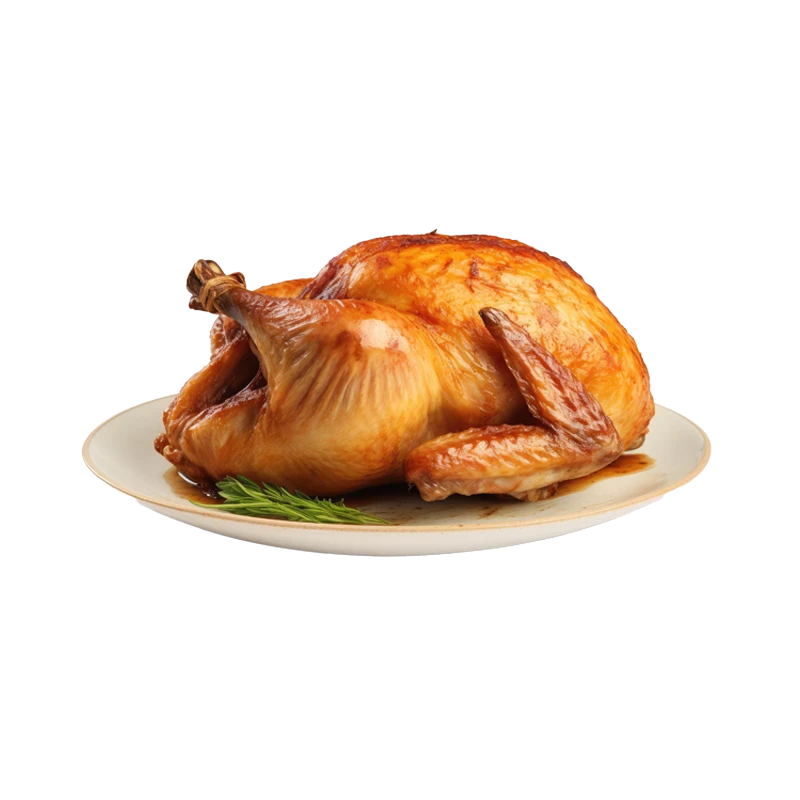Rotisserie Chicken — Nutrients, Health Benefits, And Shopping Tips

Written by Listonic Team
Last update on September 4, 2024
Rotisserie chicken nutrients
Nutrition facts
Amount per 100 g
Calories
🔥 187 kcal
| Nutrition per: 100 g | Value | % Daily Value* |
|---|---|---|
| Carbs | 0 g | - |
| Fiber | 0 g | - |
| Sugars | 0 g | - |
| Glycemic Index | 0 | - |
| Protein | 29 g | 58% |
| Sodium | 318 mg | 13.83% |
| Total Fat | 7 g | 8.97% |
*The % of Daily Value (DV) tells you how much a nutrient in a serving of food contributes to a daily diet. 2,000 calories a day is used for general nutrition advice.
29 g
💪 High Protein Content
Rotisserie chicken facts & tips
Health benefits
- High in protein, essential for muscle growth, repair, and overall body function.
- Convenient and ready-to-eat, making it a quick and nutritious meal option.
- Contains essential vitamins and minerals such as Vitamin B6, B12, niacin, and selenium, supporting overall health and well-being.
- Low in fat (if skin is removed), making it a healthy option for weight management.
Health risks
- High sodium content in many rotisserie chickens, which are often heavily seasoned, contributing to hypertension and increased cardiovascular risks.
- High fat content particularly in the skin, which can raise cholesterol levels and increase the risk of heart disease when consumed frequently.
- Potential for additives such as preservatives or flavor enhancers in commercially prepared rotisserie chickens, which may cause adverse reactions in sensitive individuals.
- Risk of contamination with harmful bacteria if the chicken is not properly cooked, stored, or handled.
How to choose rotisserie chicken
Rotisserie chicken should have a crispy, golden-brown skin and be cooked evenly all around. The meat should be juicy and pull away from the bone easily, indicating it has been cooked properly.
Avoid rotisserie chickens that appear undercooked or have rubbery skin, as these have not been prepared well. Chickens that are overly dry or have a burnt aroma should also be avoided, as they will not provide a pleasing taste or texture.

How to store rotisserie chicken
Rotisserie chicken should be stored in the refrigerator, preferably in an airtight container. Refrigeration keeps it fresh for up to four days. Reheat thoroughly before consuming.
Leaving rotisserie chicken at room temperature can lead to rapid spoilage. Avoid using dirty utensils to handle the chicken, as this can introduce bacteria. Proper storage and handling maintain its flavor and safety.
✅ Extra Tip
How long does it last?
Rotisserie chicken can last for 3-4 days in the refrigerator. For longer storage, rotisserie chicken can be frozen for up to 4 months.
What to do with leftovers?
Leftover rotisserie chicken can be used in a variety of savory and versatile dishes. Shred it and add to sandwiches, wraps, or salads for a flavorful protein, or mix it into a stir-fry with vegetables and rice. Rotisserie chicken is also great when added to pasta dishes with a creamy or tomato-based sauce, or used as a topping for pizzas or flatbreads.
Use rotisserie chicken in a casserole with potatoes, vegetables, and cheese, or mix it into a chicken soup or stew for added richness. If you have a lot of rotisserie chicken, consider making a batch of chicken enchiladas by mixing the chicken with cheese and sauce, then wrapping in tortillas and baking until bubbly. Rotisserie chicken can also be shredded and used as a filling for tacos, burritos, or quesadillas, or served over a grain bowl with quinoa, roasted vegetables, and a tangy dressing. For a quick snack, reheat rotisserie chicken and serve with a dipping sauce or on a bed of greens.
👨⚕️️ Medical disclaimer
Discover products from other categories
Listonic Team
Fact-checked
Our editorial team checked this article to make sure it was accurate at the time of publishing it.
Get the top-rated shopping list app

rotisserie chicken
1 piece
Outline







